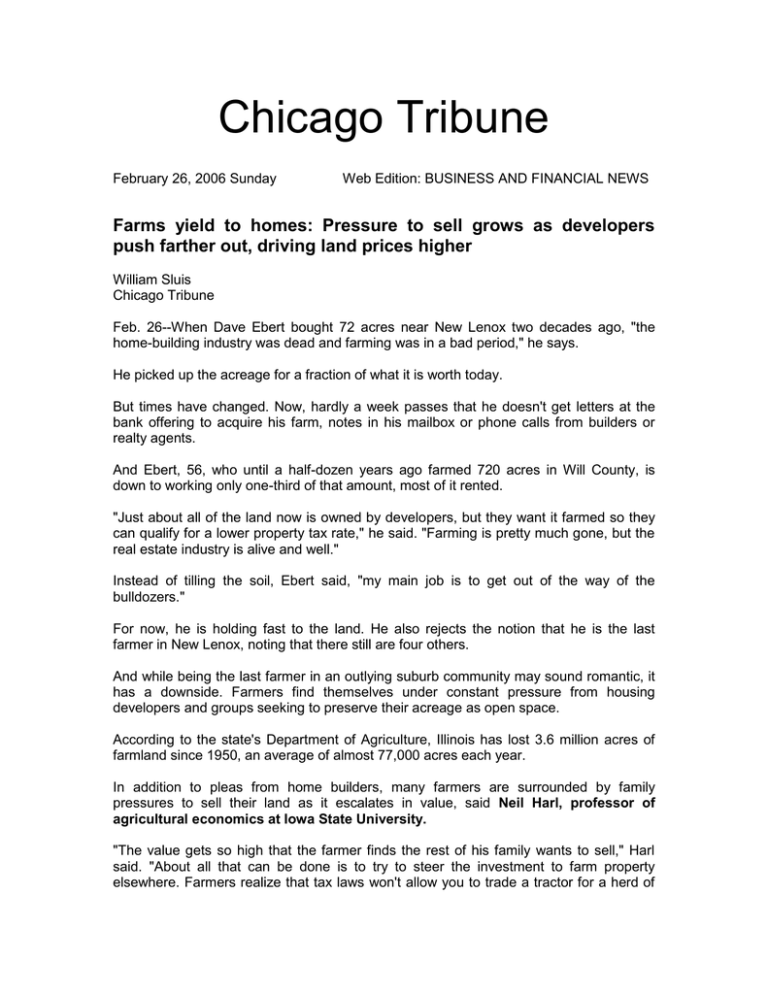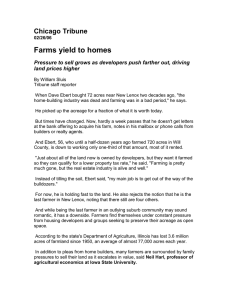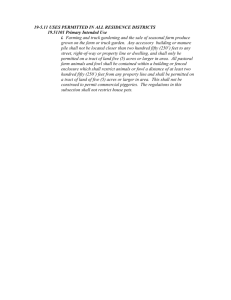Chicago Tribune
advertisement

Chicago Tribune February 26, 2006 Sunday Web Edition: BUSINESS AND FINANCIAL NEWS Farms yield to homes: Pressure to sell grows as developers push farther out, driving land prices higher William Sluis Chicago Tribune Feb. 26--When Dave Ebert bought 72 acres near New Lenox two decades ago, "the home-building industry was dead and farming was in a bad period," he says. He picked up the acreage for a fraction of what it is worth today. But times have changed. Now, hardly a week passes that he doesn't get letters at the bank offering to acquire his farm, notes in his mailbox or phone calls from builders or realty agents. And Ebert, 56, who until a half-dozen years ago farmed 720 acres in Will County, is down to working only one-third of that amount, most of it rented. "Just about all of the land now is owned by developers, but they want it farmed so they can qualify for a lower property tax rate," he said. "Farming is pretty much gone, but the real estate industry is alive and well." Instead of tilling the soil, Ebert said, "my main job is to get out of the way of the bulldozers." For now, he is holding fast to the land. He also rejects the notion that he is the last farmer in New Lenox, noting that there still are four others. And while being the last farmer in an outlying suburb community may sound romantic, it has a downside. Farmers find themselves under constant pressure from housing developers and groups seeking to preserve their acreage as open space. According to the state's Department of Agriculture, Illinois has lost 3.6 million acres of farmland since 1950, an average of almost 77,000 acres each year. In addition to pleas from home builders, many farmers are surrounded by family pressures to sell their land as it escalates in value, said Neil Harl, professor of agricultural economics at Iowa State University. "The value gets so high that the farmer finds the rest of his family wants to sell," Harl said. "About all that can be done is to try to steer the investment to farm property elsewhere. Farmers realize that tax laws won't allow you to trade a tractor for a herd of cows, but you can buy another farm." Moving to a distant area involves risks, however, Harl said, because farmland may well be overvalued, relative to the price of crops. "It's not always possible to strike it rich twice. About 25 percent of the price of land in rural areas is attributable to the value of federal farm subsidies, and those could soon be reduced." In Iowa, some farmland has risen in value by 70 percent over the last three years, he added. An acre of farmland in the state that sold for $787 about 20 years ago now goes for $2,900--a whopping increase of nearly fourfold. Yet time may be running out on the boom in farm values, according to Harl, because there are signs that the residential real estate market is weakening. While many farmers may believe they can get $200,000 an acre for their land, actual prices vary widely, said housing consultant Tracy Cross. "If you think about paying $200,000 for a piece of dirt, it figures out to something like $4.59 a square foot. Who ever heard of paying that much? It's equivalent to the cost of carpeting," he said. The big question for builders who acquire property is whether they can get rapid approval to start construction, said Cross, of Tracy Cross & Associates in Schaumburg. So-called entitlements, in which suburbs make agreements for the creation of schools, sewers and other infrastructure, are critically important, he said. "The value of land drops quickly if you aren't allowed to build," Cross added. One of the last rural outposts in the southwest suburbs is Bengtson's Farm, which draws thousands of kids and their parents every year for its autumn pumpkin festival. David Bengtson, 47, said his father sold the last of the farm's 116 acres in Homer Glen a few years ago and moved to Florida. David Bengtson, his wife, Pamela, and brother Dan operate the annual pumpkin fest, which includes hayrides, a petting zoo and haunted barn. With the family farm now entirely developed into housing, they operate the fest on rented land. And the family stopped growing its own pumpkins three years ago. "We get about 100,000 visitors a year, and let's just say running the fest is easier and more profitable than farming," said David Bengtson. "To make money in farming, you've got to have access to thousands of acres of land," he said, adding that he and his brother own more than 1,000 acres in Iowa. Tenants who farm their Iowa acreage work a total of 5,000 acres. As for neighbors in Homer Glen and Lockport Township, Bengtson said, "there still are a few farmers, but not many." Ebert says that if he sells his land near New Lenox, he would face immediate tax pressures to "roll over" the money. That would mean quickly buying a farm elsewhere in the Midwest, presumably in western Illinois. "When developers buy land here, it has the effect of raising prices for farmland 100 or more miles away," Ebert said. "People who sell land in far-off counties know that you are in a hurry to buy another farm." In southwest suburban Mokena, the last farmer was Edwin Yunker, who died about five years ago. The elder Yunker was a near-legendary figure in the community who would walk a small herd of cattle across LaPorte Road in front of his barn, halting traffic as recently as the mid-1990s. And his land didn't go to developers. Voters in Mokena were so eager to preserve his 115-acre property, which includes a large stand of old-growth oak trees, that they approved a park district referendum to buy the land for $3.25 million. Although there still is a plan to create a "working" farm with animals at his old farmstead, the first project to rise out of the ground is a recreation center. The center, which looks like a gymnasium, is nearing completion after a lengthy controversy. In Palos Park, a working farm is operated by the Community Center Foundation for the benefit of children. It bills itself as a place "where chickens lay eggs, sheep grow wool, goats give milk, fields grow hay and ponies give rides." The operation offers school tours and a Junior Farmers program, as well as weekend family tours. Kids are given an opportunity to feed the animals, including 17 horses. Elsewhere, such old-fashioned farms are becoming a memory. And as they are eaten up for housing, the fight to preserve open space grows more difficult. Consider the situation in Kendall County. According to the Conservation Foundation based in Naperville, rapid expansion of housing in the county has seen it grow to an official population of 72,548, although some estimate it actually is closer to 80,000. That's 33 percent higher than the 2000 census showed. In the next 25 years, Kendall's population will increase by 140 percent, said Brook McDonald, president and chief executive of the foundation. At the same time, only 1.5 percent of Kendall County is public open space, according to McDonald. That compares with 19 percent in DuPage County, perceived as brimming with subdivisions, office parks and shopping centers. McDonald said some farmers contact his group about obtaining a conservation easement, which would guarantee that their land can never be developed. But the numbers who seek to conserve the land in that manner are few, he added, "because the housing developers have so much money." Kane County can provide monetary help either for buying farms as open space or for setting up conservation easements, McDonald said. When northwest suburban Harvard voted in January to annex a hilly, 200-acre parcel on which to build an additional 400-plus houses, one alderman told members of the council, "people in Harvard want to see this town grow. They want more places to shop and more jobs. For that you need more people. Communities that fight growth die." A farmer in the audience, who recently sold his land, agreed, adding, "You've got to either farm it or step aside for progress. I'm for progress." One of the last farmers in Orland Township was, until several years ago, a frequent subject of television interviewers. He was seen on the "Today" show and elsewhere. The camera crews would focus on a small herd of sheep, several goats and a donkey that grazed on the front lawn of his home amid aging farm implements. The farmer and his wife also sponsored a local park district girls' softball team. They are gone now. They decided to sell the family operation and buy a farm about 75 miles away, near Bloomington. Across from where their small family house once stood, there is a new bank, a strip mall and a Jewel supermarket. Most of their land has been subdivided for $300,000 homes. And on the corner near the pasture where the sheep once roamed stands yet another strip mall, anchored by Walgreens.





